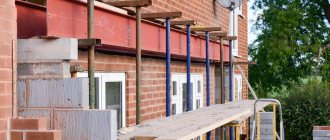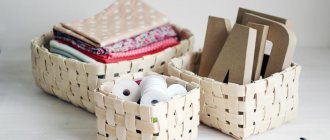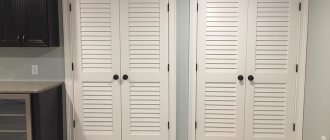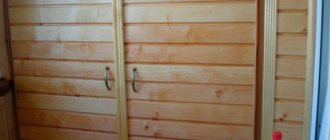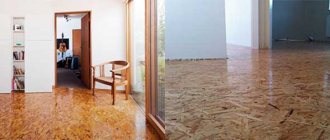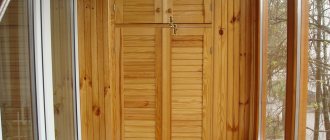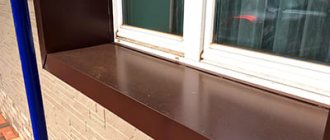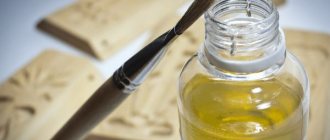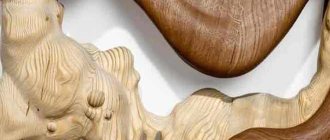Wood is a material that has long been used for cladding baths and saunas. It is there that wood best reveals its properties - the ability to create a microclimate and retain heat perfectly.
In truth, there is simply no alternative to wood for use in humid and hot environments. Accordingly, it is better to line the inside of the bathhouse with wooden clapboard. Below is the technology for step-by-step cladding of a bathhouse with clapboard inside.
Lining the bathhouse with wooden clapboard inside
Finishing a bathhouse or sauna with clapboard has its own characteristics that must be taken into account at the stage of selecting wood.
When choosing lining for cladding a bath, you need to consider:
- high temperature;
- temperature fluctuations (drops);
- humidity level;
- budget.
What to hammer in: nails, screws or staples?
The lining itself is a board with a certain profile, which must have a tongue-and-groove locking connection. It is attached to the wall or ceiling using nails, screws or staples. The tools and material required to hammer in the lining in the bathhouse are as follows:
- nails, screws, staples;
- hammer, screwdriver, hardware gun;
- a mallet or a piece of clapboard for knocking a tenon into a groove;
- building level.
What nails should I take for the lining in the bathhouse? It is desirable that these are finishing nails 30-40 mm long, with an anti-corrosion coating . It’s worth taking coated screws (their length is the same, by the way). Regarding the length, you should proceed from the thickness of the board (if in a groove, then only the walls of the groove), plus you need to punch through the block to which the board is attached at least to the middle.
The staples should be the same size, although there are comrades who nail 14-mm staples with a construction stapler through a clamp, but this is rather an exception. To properly line a bathhouse with clapboard, it is better to use long staples and shoot them at an angle of 45 degrees (approximately).
Of course, it is tempting to wonder which of these methods is better . There cannot be a definite answer to this, because everything depends on the experience of a particular person. And if it is not there, then the easiest thing to do is to shoot the staples using a pneumatic gun. True, it is not cheap, and few people would agree to buy it for a one-time job. Other methods are a little more difficult to implement.
Necessary tools and accessories
- Electric drill with a set of wood drills.
- Electric jigsaw.
- Wood saw.
- Set of wood rasps.
- Hammer.
- Hatchet.
- Mallet.
- Furniture stapler with a set of staples.
- A device for sawing bars at an angle.
- Level.
- Roulette.
- Yardstick.
- Carpenter's square.
- A ruler for drawing the outline of a log house.
- Plumb.
- Rope.
- Metal clamps for lining.
- Pencil.
Additional materials on the tool can be found here and here.
Return to content
How to mount: with or without clamps?
In another article, we even held a vote to find out how many fans the claimers will have and how many opponents there will be. Here we will simply list the reasons why those same clamps were invented.
The fact is that dry wood (and it is best to use dry wood in construction and finishing) easily splits if a point force is applied to it. Which is exactly what happens when you drive nails or screw screws through a groove in a board. Quite often the bar breaks.
This can be completely avoided if you do not punch through the plank at all, but use a clamp - a metal “claw” that fixes the plank to the sheathing bar. Hidden installation is greatly simplified when you only need to nail the clamp with a nail, screw or staple through convenient holes.
There are practically no disadvantages to clamps if they themselves are made of high-quality metal and have a coating that protects them from rusting.
ATTENTION! The clamps are selected according to the thickness of the groove and it is advisable to take ones that you cannot crumple in your fingers, like a sheet of tin - the harder the metal, the better.
How to line a bathhouse with clapboard using clamps is shown in the following video:
Work procedure
Wooden lining can be used to decorate living rooms of almost any design style, either completely or partially, see fig. In the latter case, lining can be an effective means of zoning a room, top left in Fig.
Living rooms decorated with clapboard
The walls are finished with clapboards in the following order:
- Preparing the building: if the walls are porous or cold (they conduct heat well) - insulation and waterproofing from the outside. Possibly also external decorative cladding. Neglecting this point will bring all efforts to create beauty inside to nothing;
- Choice of material – wood species, profile and width of the lining boards;
- Choice of cladding scheme: horizontal, vertical, diagonal, shaped;
- Preparation of the internal base surface - leveling, vapor/water insulation;
- Installation of sheathing under the cladding;
- Wall covering with clapboard, using standard or simplified technology. In terms of strength and decorative qualities of the cladding, they are equivalent, the differences are different, see below;
- Applying a protective coating to the casing;
- Installation of sockets, lamps and other devices built into the wall;
- Applying skirting boards to expansion gaps, corners of window slopes and door quarters.
How to lay: horizontally or vertically?
Unfortunately, when choosing a method for cladding the inside of a bathhouse, we cannot be guided only by aesthetics. More precisely, not so: aesthetics can be the basis of choice only in a dry room , for example, in a rest room or dressing room.
If you decide to use it to decorate wet rooms (steam rooms and washing rooms), then it is better to focus on a method that minimizes future losses . By “losses” we mean possible damage to the planks from moisture, which will require their replacement.
So, what happens when the installation of lining in a bathhouse is carried out vertically? In a humid room, humidity is distributed unevenly - after all, gravity drives it towards the floor. As a result, each (!) plank also gets wet unevenly.
When it dries, this can lead to cracking, but more often, over a long period of time, problems accumulate at the bottom - somewhere there is not very good ventilation, for example, and in this place the water stagnates. Therefore, the planks begin to rot. And since we have them located vertically, the rotting area affects all the planks.
This is what’s inconvenient - in order to dismantle and replace damaged areas, you will have to cut (not replace the whole thing!), and then replace each piece. The cost of time and effort is especially clearly visible if we compare the situation with the horizontal upholstery of a bathhouse with clapboard - in this case , several strips are replaced entirely, which does not cause any special problems in dismantling and installation.
The only disadvantage of horizontal cladding of a bathhouse from the inside with clapboard can be considered a visual reduction in the height of the sheathed room, and in the bathhouse, as you know, the ceilings are already low. Therefore, as an option, you can combine both methods using the horizontal one at the bottom.
What is the purpose of foil?
To achieve effective energy saving in a bathhouse, you will need to not only insulate it, but also use reflective material in the form of a special foil film. Masters claim that it helps return up to 95% of the heat into the room.
The result is that fuel for the stove is saved and the duration of the fire is reduced.
For baths, aluminum foil with a thickness of 30–300 microns is used. It is used in combination with other insulation or is already fixed as its top layer.
Therefore, before covering, they first attach insulating material to the walls and ceiling, thanks to which the heat does not escape beyond the bathhouse. An insulated steam room heats up faster and retains heat longer.
The following are the advantages of foil:
- It acts as a vapor barrier and blocks the access of moisture to the insulation. The generated steam remains on the walls of the steam room.
- Its service life exceeds 50 years. Wooden elements will begin to rot faster than the foil layer will deteriorate.
- Excellent sound insulation. Foil can absorb up to 70% of all sounds and noise.
- Fireproof raw materials. Does not burn. It will become an obstacle to the spread of fire.
- Bathrooms warm up faster and take longer to cool down.
- If you fix the insulation with a foil layer, then the foil will prevent it from falling off.
Among the disadvantages, the following should be noted:
- When there is a difference in temperature outside and indoors, condensation appears on the surface of the material.
- It is important to leave a gap for ventilation before covering. If this is not done, the resulting condensate will begin to be absorbed into the sheathing, which will lead to rotting of the lining.
- Foil has poor throughput. As users say, she is not breathing. Therefore, the rooms must have good ventilation, both forced and natural (windows, doors).
- Aluminum particles accumulate in the lungs, causing various respiratory diseases. But if you use the sauna periodically, the risk of harm to health is minimal.
To achieve the maximum effect from using foil, it is important to follow the tips for installing thermal insulation step by step.
How to sheathe a steam room correctly
If the argument regarding horizontal laying is accepted, then this is one of the main points on how to properly line a steam room in a bathhouse with clapboard.
Because the rest concerns only the issues of preventing such expansion of wood , which will lead to a violation of the geometry of the wall.
The easiest way would be to avoid swelling of the planks by using boards made of linden wood. Linden is a material that exhibits low expansion when moistened. That is why it is used for the manufacture of bath doors (as well as furniture) - the most sensitive to changes in dimensions.
It would also be worth leaving compensation gaps along the edges of the wall, covering them with decorative strips. These gaps could also serve as ventilation gaps if some distance is left between them and the covering strips.
In general, it’s surprising - in some cases the lining holds up perfectly even in the absence of any tricks for this, but in others it doesn’t just swell, but manages to pull out nails or screws and generally crumble. We believe that its behavior is influenced by the extent to which the tree was dried at the harvesting stage , and the type of wood , of course, too.
Covering saunas and baths - is there a difference?
Since we have repeatedly mentioned on this site that the Finnish and Russian baths differ from each other in temperature and humidity, and also require specific conditions that create their inherent combination of temperature and humidity, it is logical to extend this to the clapboard cladding of saunas and baths.
But the answer will still be negative. The only difference is that followers of the Russian tradition can use coniferous species in the steam room with less caution, because the Russian bath does not like high temperatures. Well, at least you won’t get burned by the resin if it decides to leak
